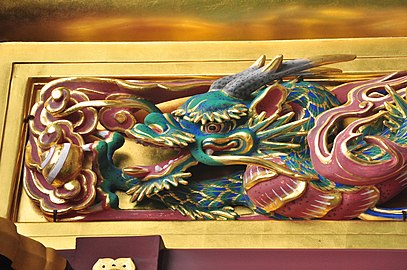art.wikisort.org - Artist
Hidari Jingorō (左 甚五郎) was a possibly fictitious Japanese artist. Some people and sources state his real name was Itami Toshikatsu.[1] A Renaissance man, he worked as a sculptor, carpenter, painter, architect, comedian, actor, kōdanshi (rhythmical storyteller) and professor of art. Although various studies suggest he was active in the early Edo period (around 1596–1644), there are controversies about the historical existence of the person. Jingorō is believed to have created many famous deity sculptures located throughout Japan, and many legends have been told about him. His famous nemuri-neko ("sleeping cat") carving is located above the Kuguri-mon Gate amidst the sacred mountain shrines and temples of Nikkō, Japan. Amongst these shrines and temples is Nikkō Tōshō-gū, a shrine that honors the Shōgun Tokugawa Ieyasu. The two dragon carvings at the karamon in Ueno Tōshō-gū are also attributed to him.[2]

Other sculptors were reportedly jealous of how skilled a carpenter Hidari was, to the point of chopping off his right arm. Luckily he was left-handed and was able to keep working, the reason why he acquired his last name Hidari[3] (meaning "left"). According to another theory, he was an apprentice to a blacksmith and made katana swords. After working there a while, Jingorō felt he deserved to know what temperature the oil was kept at. Against his boss's permission he attempted to test the temperature of the oil by touching it and his boss cut off his right hand. When he realized he could no longer be a blacksmith he became an apprentice for the Chief Architect Hokyo Yoheiji Yusa of the Imperial Court in Kyoto, where he studied how to build temples, shrines, and sculptures.
Stories about Jingorō are well known in Japan. According to one, he saw a woman of exceptional beauty and created a sculpture of her. Jingorō began to drink in the company of the sculpture, and it emotionlessly started to imitate his moves. When a mirror was placed before the sculpture, the woman's spirit came to life.
- Carving of a sleeping cat at Nikkō Tōshō-gū, said to be the work of Jingorō.
- Carving of a dragon at Ueno Tōshō-gū, also attributed to Jingorō.
See also
| Wikimedia Commons has media related to Hidari Jingorō. |
- Pygmalion (mythology)
References
- "Hidari Jingorō • . A History . . of Japan . 日本歴史". . A History . . of Japan . 日本歴史. Retrieved 2022-02-11.
- English information panel at Ueno Tōshō-gū.
- Minna no Nihongo Shokyuu, Lesson 37.
Further reading
- Zempei Matsumura, Nikkō Tōshō-gū Shrine and Hidari Jingorō, Nohi Publishing Company, Japan, 1975.
На других языках
[de] Hidari Jingorō
Hidari Jingorō (japanisch 左 甚五郎) war ein japanischer Architekt und Bildschnitzer Anfang des 17. Jahrhunderts.- [en] Hidari Jingorō
[es] Hidari Jingorō
Hidari Jingorō (左甚五郎, Hidari Jingorō?) fue un artista japonés posiblemente ficticio. Trabajó como escultor, carpintero, pintor, arquitecto, comediante, actor, kōdanshi (narrador rítmico) y profesor de arte. Aunque varios estudios sugieren que estuvo activo a principios del período Edo (alrededor de 1596-1644), existen controversias sobre su existencia histórica. Se cree que Jingorō creó muchas esculturas de deidades famosas ubicadas en todo Japón, contándose muchas leyendas sobre él. Su famoso grabado Nemuri-neko (gato durmiente), se encuentra sobre la puerta Kuguri-mon del santuario al Shōgun Tokugawa Ieyasu, Nikkō Tōshō-gū, en Nikkō. También se le atribuyen los dos grabados de dragón del karamon del santuario Ueno Tōshō-gū.[1][fr] Hidari Jingorō
Hidari Jingorō (左 甚五郎, Hidari Jingorō?) est un artiste gaucher japonais sculpteur et charpentier peut-être fictif. Bien que diverses études suggèrent qu'il a été actif au début de la période Edo (autour de 1596-1644), son existence même est sujet à controverses.[it] Hidari Jingorō
Hidari Jingorō, (左 甚五郎?), oppure Hingorō (1584 – 1644), è stato un architetto e scultore giapponese.[ru] Хидари Дзингоро
Хидари Дзингоро (яп. 左 甚五郎 Хидари Дзингоро:) — легендарный японский художник, скульптор и архитектор. Художник работал левой рукой, его прозвище Хидари означает левша.Другой контент может иметь иную лицензию. Перед использованием материалов сайта WikiSort.org внимательно изучите правила лицензирования конкретных элементов наполнения сайта.
WikiSort.org - проект по пересортировке и дополнению контента Википедии

